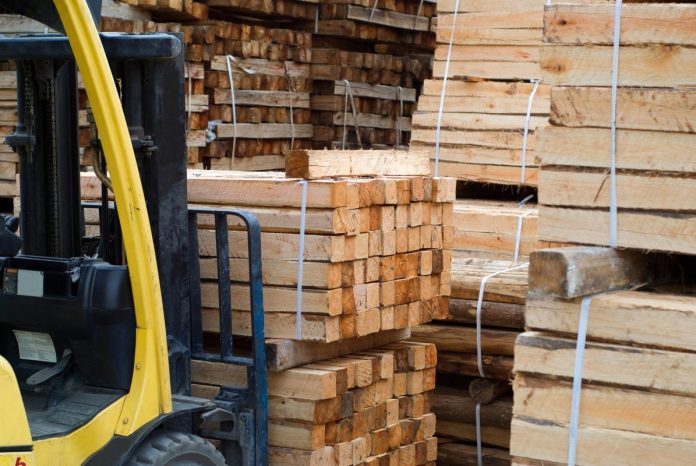Herje Bojström, CEO of Sioo Wood Protection AB in Sweden highlights the benefits of protection systems to reduce the impact that weather has on wood
Although wood is an incredibly versatile and beautiful material it does suffer from some problems. For exterior applications in Use Classes 3.1 and 3.2 (EN 335 Part 2) wood in exposed conditions will weather to give a silvery-grey driftwood appearance. However, when wood is sheltered (such as under overhanging eaves) then the wood will retain its original colour. This leads to a very unsightly appearance with uneven weathering, examples of which are not hard to find.
The weathering of wood has been researched for over 100 years, and although we understand very well why it happens and what causes it, there has never been a solution developed. Wood is composed of three structural polymers: cellulose, hemicelluloses and lignin. It is the lignin that is the Achilles heel where wood weathering is concerned. Lignin is a cross-linked phenolic polymer that imparts a brown colour to wood and is the ‘glue’ that holds wood cells together and gives wood its stiffness.
However, lignin also strongly absorbs ultraviolet light which causes the breaking of chemical bonds and leads to fragmentation of the lignin polymer. These lignin fragments are then washed out by rain, where they become food for staining microorganisms, leading to the familiar grey appearance. Because the lignin is no longer present, the cell walls at the surface become loose and can be washed away in the rain. Although this is not a problem with uncoated wood, it most certainly is an issue for clear coated wood because the coating no longer adheres to the wood surface, meaning regular and expensive maintenance is required.
Conventional wood coatings
Conventional wood coatings rely on adhesion to the wood surface for their integrity. Over time, the movement of the wood under the coating due to the effects of wetting and drying result in localised failure of the coating, usually at the earlywood/latewood boundary. Once this happens, liquid water is able to penetrate below the surface of the coating, which is then forced off due to hydrostatic pressure. The only remedy is to sand back to good material and re-coat. The only way to stop this from happening is to use more flexible coatings, but this is not feasible because the coating would then be tacky and pick up dirt very rapidly in service.
Conventional paints and varnishes also use carbon-based chemistry, and carbon-based compounds are susceptible to UV degradation when exposed to sunlight. Clear coatings suffer from the additional problem that the wood underneath is susceptible to UV degradation, and failure can also occur because the surface layers of the wood start to lose their structural integrity as the lignin (which binds the wood cells together) degrades. Putting UV stabilisers and filters in the coatings may slow down this degradation to some extent, but it is the wood that is the Achilles heel in the clear-coating system.
The Sioo:x Wood Protection System is different; it is not a coating, but an envelope. The protection system has two components; the first (the wood protector) penetrates the wood where it gradually forms an inert glassy polymer, by reaction with atmospheric carbon dioxide. The second component (the surface protector) acts to seal and protect the first application until it is fully cured, but it also forms an inert water-resistant envelope which penetrates the wood and gradually creates a grey surface appearance. It does not stop the lignin from degrading, but it takes the same role by keeping the wood cells glued together, essentially using the strength of glass. The Sioo:x polymers that form in the wood have silicon-oxygen bonds (the same as in glass) and are completely UV stable.
Sioo:x is a patented (WO2007111556) water-based 2-part wood surface treatment process that was developed in Sweden over 15 years ago. The wood protector undergoes a chemical reaction with atmospheric carbon dioxide to deposit insoluble silica particles into the wood. The surface protector prevents leaching of the wood protector until it is fully cured. It is the even-ness of the silvery-grey appearance that is one of the most attractive features of the product. The product works best when there is good penetration of the wood material: rough sawn surfaces are always preferred and planed surfaces must be sanded to break through the machining glaze. Curing is accelerated with higher temperatures, but applying in direct sunlight is best avoided since rapid drying of the water-based product will limit diffusion into the wood.
Application in damp, cold conditions is also to be avoided since curing is slowed down and there is a risk that the wood protector will be leached out before curing has occurred. For these reasons a factory-applied finish by a Sioo:x accredited treater is always the best option. The treatment can be applied using brushing or spraying and good penetration is the key to good performance.
Herje Bojström
CEO
Sioo Wood Protection AB
Tel +46 (0)31-42 42 62
Please note: this is a commercial profile











